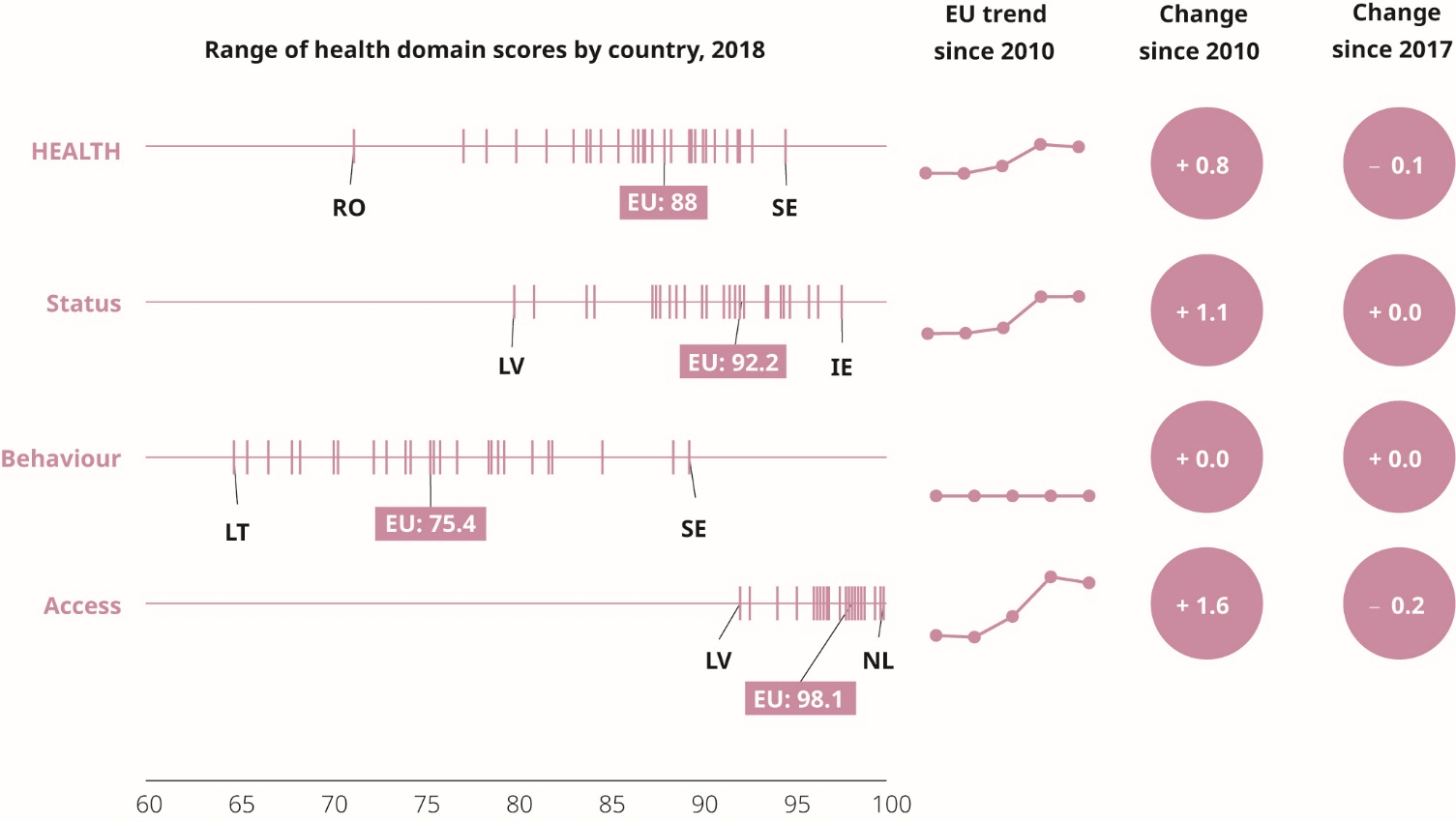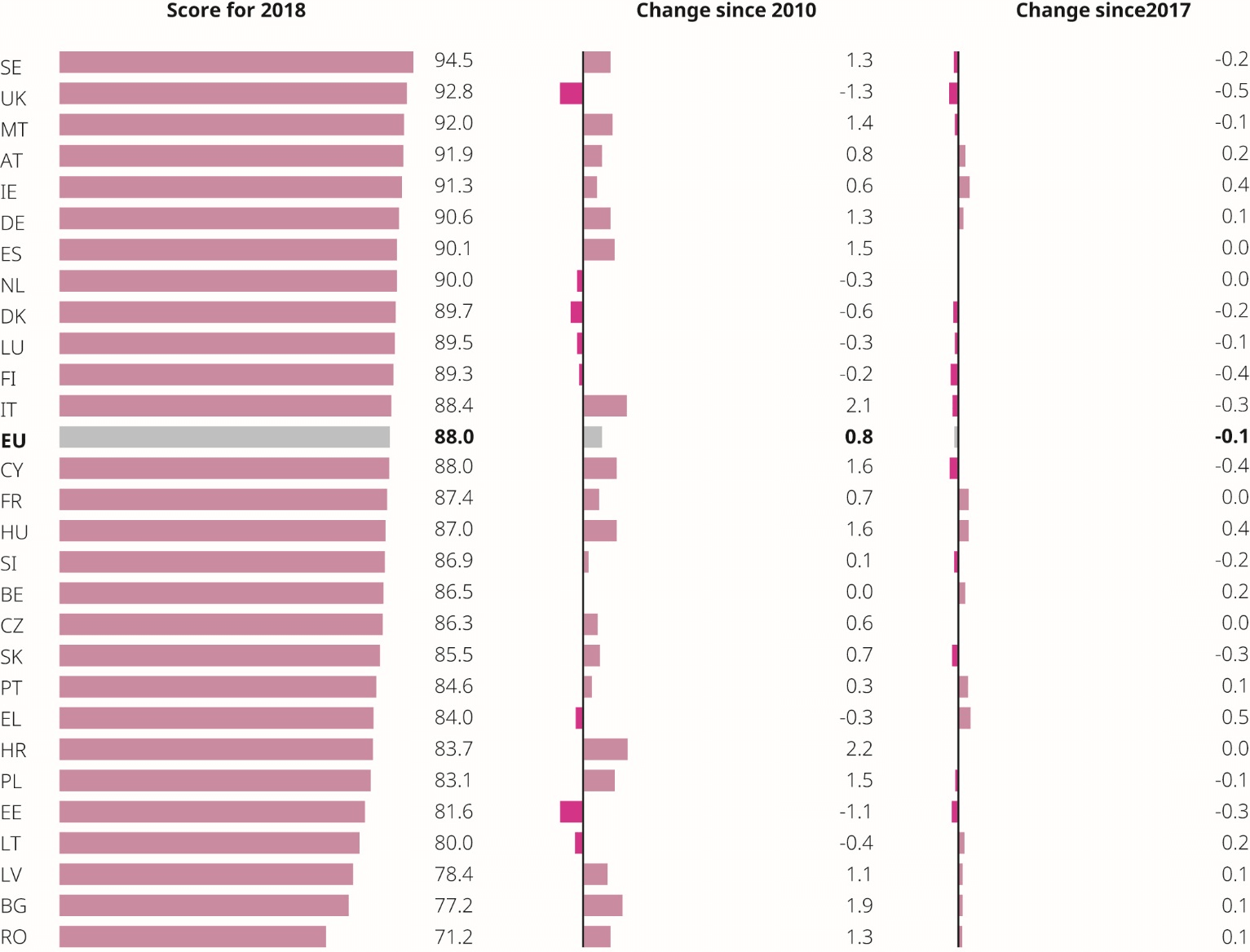Lack of data obstructs monitoring of gender progress on health behaviour
The 2020 Gender Equality Index still reflects the pre-COVID-19 period. Although its score of 88 points sees the domain of health[1] ranked the highest of all six domains, progress has been negligible (+ 0.8 points) since 2010 (Figure 21). The latest year even showed a minor loss in progress, of – 0.1 point.
Since 2010, 12 countries have improved their score by more than 1 point, with Sweden and the United Kingdom alternating between 1st and 2nd position. The most significant progress was in Croatia, Italy and Bulgaria. Seven countries experienced some decrease, while two lost over 1 point (Estonia and the United Kingdom). In the short term, from 2017 to 2018, the changes ranged from a mere + 0.5 points in Greece to – 0.5 points in the United Kingdom.
The subdomain measuring equal access to health services had the highest score and showed most rapid progress (+ 1.6 since 2010), although 2018 saw a slight backslide of 0.2 points. Bulgaria was the most prominent improver in equal access (+ 5.9), which lifted the country from 26th to 10th position in this subdomain. Croatia, with its 5.2-point improvement, rose from 25th to 13th in the ranking. The third fastest improver, Romania, went up by only three positions to 24th place, despite a 4.4-point improvement (Figure 22).
Figure 21. Scores for the domain of health and its subdomains (2018), and changes over time
Changes since 2017 were marginal everywhere in the subdomain of access. Only the United Kingdom lost 1.1 points, continuing the gradual decline since 2010 that has seen it fall from 4th to 22nd in the rankings. Estonia’s access to services score also declined: it lost 4.2 points (– 0.9 since 2017) and dropped from 15th to 27th position. Latvia has remained in last (28th) position throughout the years.
The subdomain of health status is much less dynamic, in terms of both scores and rankings. The score for the EU has improved by 1.1 points since 2010 and shows no change since 2017. Croatia (+ 2.3), Italy (+ 3.2), Hungary (+ 3.3) and Slovakia (+ 2.4) are most improved since 2010.
Since 2017, five countries have improved their score by at least 1 point, with Greece improving most (+ 1.1 points). Estonia, Latvia, Lithuania and Portugal have been at the bottom of the board throughout, but Lithuania (+ 1.0) and Latvia (+ 0.9) show slight improvements since 2017.
Luxembourg went backwards by 2.3 points, falling from 5th position in 2010 to 14th in 2018. In 2018, Cyprus and Denmark lost most points (1.4 and 1.3, respectively).
The largest gender inequalities are found in health behaviour: the score at EU level is a mere 75.4 points. Data show that men are more likely to engage in smoking and drinking, while women are more likely to eat healthily and engage in physical activity. These are major health determinants and closely related to the type of health prevention that can lessen the need for expensive attempts to cure illness or manage disease over the long term (WHO, 2008).
The latest data on health behaviour are from 2014, making it impossible to monitor progress on this important area effectively. There is a body of evidence showing that legislative and public policies can be effective in changing behaviour (WHO, 2014b), but regular data collection and analysis are essential to monitor the effectiveness of Member States’ approaches.
Figure 22. Scores for the domain of health, and changes since 2010 and 2017, in the EU Member States

